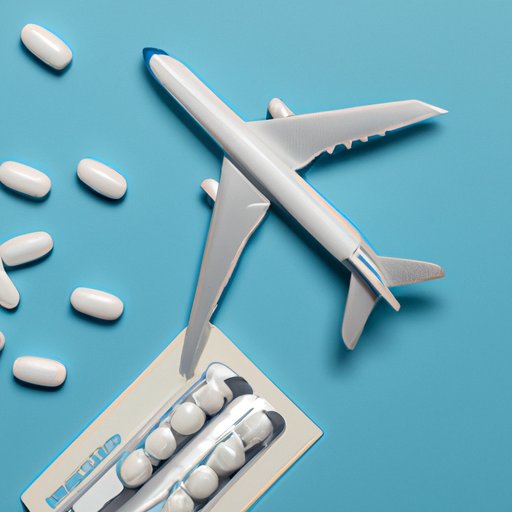
Introduction
Traveling can be stressful, especially when you need to bring medication on a flight. Knowing what medications are allowed and how to pack them can make a big difference in easing that stress. In this article, we will explore TSA regulations, airline policies, packing tips, and more to provide you with a comprehensive guide to traveling with medication.
Navigating TSA Regulations: What Medications You Can Bring on a Flight
Before packing your medication, it is important to understand TSA regulations to ensure a smooth screening process. TSA allows both prescription and over-the-counter medications, as well as some medical equipment, such as nebulizers and CPAP machines.
Medications that are allowed include pills, tablets, capsules, and other solid medications. Liquids, gels, and aerosols are also allowed, as long as they meet the 3-1-1 rule. You can bring a quart-sized bag of liquids, aerosols, gels, creams, and pastes through the checkpoint. Each container must be 3.4 ounces (100 milliliters) or less per item. Medications that are medically necessary and exceed the 3.4-ounce limit are permitted but must be declared for inspection.
When packing medication, it’s helpful to keep them in their original labeled containers to avoid confusion at the airport. TSA screening agents need to verify that the medication is really medicine. You are not required to have a prescription for medications, but it may be helpful to have a copy of your prescription with you.
Flying with Medications: Tips to Ensure Safe and Easy Travel
Packing medication for safe travel starts with knowing what medication you need. Make a list of all medications, including dosages, and carry it with you. Pack medications in your carry-on bag to ensure easy access.
When packing, be sure to keep medications in their original containers to show TSA agents during screening. If you have liquid medication that exceeds the 3.4-ounce limit, it will require additional screening. It is a good idea to alert the TSA officer that you have medically necessary liquids.
If you require refrigerated medication, such as insulin, make sure to pack reusable frozen gel packs. You can ask a flight attendant for a refill of ice, but it is important to make sure medication stays at the correct temperature.
It’s also important to prepare for unexpected emergencies. Pack extra medication in case of travel delays or lost luggage. Bring a copy of your prescription, medication information, and your doctor’s contact information.
For long-haul flights, it is helpful to pack medication in a separate bag or pouch that can easily fit in your carry-on. You may also want to bring nonprescription items such as antacids, pain relievers, and motion sickness remedies.
Know Before You Go: Understanding Airline Policies on Bringing Medication
While TSA regulations are consistent across all airports, airline policies may vary. It’s important to understand the policies of the airline you are traveling with, especially for international flights.
When traveling internationally, it is helpful to bring a letter from your doctor describing your medical condition and the medications you are taking. It’s important to research the country you are traveling to, as some medications are illegal in certain countries.
If you require medical equipment, such as a wheelchair or oxygen tank, it is important to contact the airline ahead of time to ensure that the equipment can be accommodated on the flight.
The Ultimate Guide to Packing Medications for Your Flight
Packing medication can be overwhelming and confusing, but a little organization can go a long way. Here are some tips for effective packing:
- Keep all medication in a designated spot, such as a pouch or a small bag, to keep it from getting lost.
- Place medication in your carry-on bag to ensure easy access.
- Keep liquid medication in its original container and pack it in a clear, plastic bag.
- Label medication with your name, medication name, and dosage.
- Bring a copy of your prescription and a list of medications with dosages.
It is also important to store medication in a safe place during the flight. Avoid exposing medication to direct sunlight or high temperatures.
If a medication is lost or damaged during travel, contact your doctor as soon as possible for a replacement prescription.
Exploring Prescription Medications and Air Travel: What You Need to Know
If you need prescription medication for your trip, it’s important to know the regulations regarding traveling with medication.
You can bring prescription medication on a flight without a prescription, but it is recommended to carry a copy of your prescription with you. You can also ask your doctor for a letter outlining your medical condition and the medications you need.
For those who require medical marijuana, it’s important to research state laws and airline policies before traveling. Some states have legalized medical marijuana, but it is still illegal at the federal level, which means it is not allowed on flights. Consult your doctor and review the airline’s policy before traveling with medical marijuana.
Top 5 Medications That Are Banned from Flights: Are Yours on the List?
There are some medications that are banned from flights, either for safety reasons or for being illegal in certain countries. Here are the top 5 medications that are banned from flights:
- Codeine
- Oxycodone
- Hydrocodone
- Morphine
- Fentanyl
If you require these medications during travel, it’s important to speak with your doctor and the airline before your flight. They may be able to provide alternative medication or make arrangements for your needs.
Conclusion
Traveling with medication can be overwhelming, but it doesn’t have to be. By understanding TSA regulations, airline policies, and smart packing techniques, you can ensure a safe and easy travel experience. Don’t forget to prepare for unexpected emergencies, pack extra medication, and keep a copy of your prescription with you. With these tips, you can pack your bags and take off with confidence.




